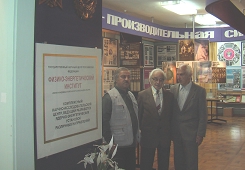
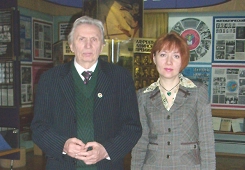
Nuclear history as the history of mankind was created zigzag. And now after prolonged Chernobyl syndrome, time of nuclear renaissance is coming. Mankind as if awakening after lethargic sleep and begins to realize that without generous atom it will never step to the future, never will overcome violent energy hunger. Now it is clear for politicians, scientists and common people. For the time being only nuclear energy opens the real way to the abundance of energy and it means to the stable peace on the planet. It is an evident historic fact. And it is also a way to the global historic responsibility for the present and for the future of the world. Mother-history can be here of great help to the mankind, that draws future from it - history is like a teacher, a tutor, a reminder about mistakes of the past. And history can't exist without museums - its careful witnesses and curators.
Hand-reared atom on earth, under water and in space. Excursion in the IPPE museum.
How were the neutron- and thermalphysic calculations of the ÀÌ reactor implemented? Abacus of M.E.Minashin, logarithmic slide rule of V.S.Liashenko - are the unique exhibits of the museum. Record from the archives - economic background of "B" laboratory. What has remained from the turbine of the First NPP? IPPE founders - D.I.Blokhintsev, A.I.Leipunsky. The first strategist of the fast neutron reactors A.I.Leipunsky. Unique commercial fast neutron reactor. Philosophical proceedings of I.I.Bondarenko - scientist, philosopher, citizen. Energetics of remote space. How do the electrogenerating channels of the unique Russian space reactors with direct energy conversion look like? "Levsha" from Obninsk V.A.Malykh - inventor of fuel element for the ÀÌ and space reactors. Nuclear submarine that is faster than a torpedo and some more…
Founding Fathers of IPPE museum (left)
Mikhail Gaidin and Inna Mokhireva (right)


Museum was created 30 years ago on the initiative of the party committee by the talented enthusiasts, IPPE research workers - Oleg Vasilievich Kommisarov, Vladimir Alekseevich Ivanov, Nikolai Aleksandrovich Yaroslavsky with the participation of all the departments of the Institute.
Real enthusiasts of the museum pursuit, curators of the nuclear history - Mikhail Gaidin and Inna Mikhailovna Mokhireva helped us to touch "the small world of the large history".
From "11 horses" in the laboratory "B" to the electricity from the nuclear power plant supplied to the network of "Mosenergo" over 8 years - that is the labour exploit of the nation!
In 1945 in USSR was made an "inventory" of physicists in all the sectors, including professors in universities. They appeared to number 1500 people. But the tasks were outrageous - to overtake and surpass Americans that had already had nuclear weapons, enormous uranium enrichment shops that could be served only on bicycles or motorcycles.
Copy of the internal memorandum of L.S.Buianov addressed to A.P.Zaveniagin.
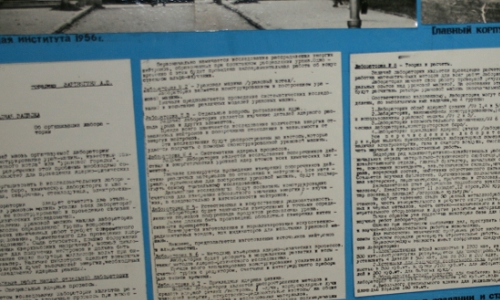
Extract from the internal memorandum from the 21th of September 1946 of the head of the laboratory and facility "B" L.S.Buianov addressed to the Deputy Minister of the Interior A.P.Zaveniagin about the organizing of laboratory "B" within NKVD (people's commissariat of interior affaires) in Obninsk:
"Farm staff vacancies are filled up with 35 people. Farm has 11 horses, 12 cows, 200 chickens and 12 hectares of cultivation area (truck crops). 30 different metalworking machine-tools were supplied to the facility, some measuring and cutting instruments, 30 tons of ferrous and nonferrous metal, number of mechano-optical and electrical-measuring equipment and other different materials."
Can you only imagine what was the background of the Soviet nuclear history like? It is the document for the year 1946! But the situation was the same on other facilities. Nevertheless they managed to overtake Americans. Just in three years from that time the First Soviet nuclear bomb would be tested and in eight years in Obninsk the First Nuclear Power Plant would start working.
Arithmometer "Felix-M" (left on the cupboard).
Fuel element end of the First NPP reactor (left on the stand).
Block of graphite stacking of the First NPP (front).
Abacus of M.E.Minashin (on the background).
Blade of the turbine of the First NPP (right corner of the cupboard).
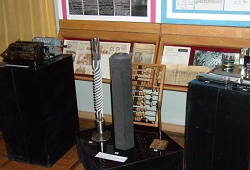

Look at these unique exhibits. Here you can see the block of graphite sharing of the First NPP, and behind it - simple abacus of Mikhail Egorovich Minashin. Nearby, on the other stand - logarithmic slide rule of Vasily Savvich Liashenko. Namely these historical abacus and slide rules were used to make physical and thermal designs of the First NPP in the world.
The way this abacus appeared in the museum that is another story. We have started a new educational program "Nuclear project in the grandchildrens' eyes". Grandniece of Mikhail Egorovich wrote a work about her father that was successfully presented on one regional and two All-Russian student's conferences. Grandmother decided to hand over to the museum such a rear relic as gratitude.
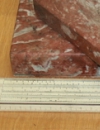 Abacus was used to add and subtract, and a slide line - to divide and multiply. This way were implemented rough calculations. And a more precise technique was in the neighboring room: young girls were chattering by the arithmometers. Operations that demanded weeks and months at that time now are made in a split second by modern computers.
Abacus was used to add and subtract, and a slide line - to divide and multiply. This way were implemented rough calculations. And a more precise technique was in the neighboring room: young girls were chattering by the arithmometers. Operations that demanded weeks and months at that time now are made in a split second by modern computers.
Turbine blade of the First NPP
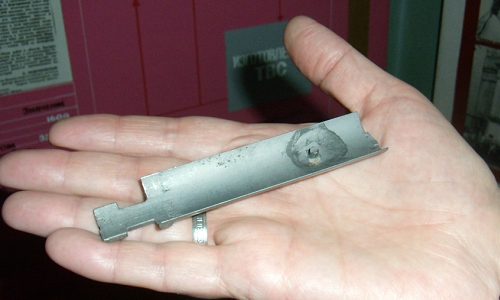
And here we have one more unique exhibit - turbine blade of the First NPP. One of that famous "Mania", made in the beginning of the 20th century by the German company MAN. Exactly that turbine was the first one that was rotated by the vapour, produced by the nuclear energy.
Unfortunately, when it was decided to use AM as a research reactor, turbine was demounted and scraped by a fatal coincidence. Enthusiasts managed to save only several parts of the turbine; one of those is exhibited in our museum.
The first NPP was generating energy for a shot period of time and its output was insignificant - only 5 Mwe. Because of the rush a lot in construction of the power plant was not finished. Water leaks in the reactor were increasing. Less than in two months arouse a question of closing the power plant. "We are the first and that is enough, there is no need to lead to trouble." - big bosses were saying. But Efim Pavlovich Slavsky, Minister of average engineering industry, decided to act in a different way. Turbine was demounted and after some modifications the First NPP was turned into the unique scientific laboratory, where the elements of future NPP constructions were tested. Exactly on the First NPP the first vapour reheater channels for the Beloyarskaya NPP and unique channels for the space reactors BUK and TOPAZ have been tested.
Measuring instruments of the First NPP
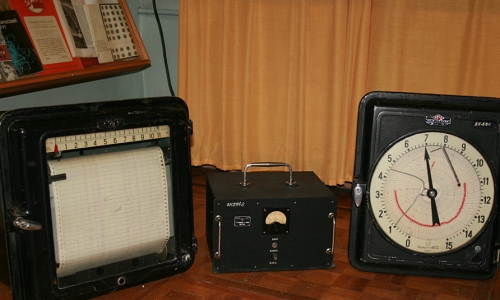
Under own power to Brussels
Transportable NPP TES-3
(on the right photo - Yury Gagarin on TES-3)
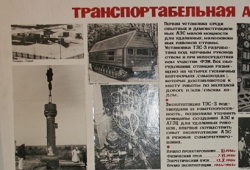

Next section of our exhibition - small Energetics, unfairly kept in the background of its big successful brothers. On this stand you can see the picture of the transportable NPP TES-3. It was the first nuclear facility among experimental and demonstrational low-power NPP, created for the remote and thinly populated regions of the country.
All equipment fitted into the four self-propelled track-type platforms. On one of those was placed a reactor, on the second - control unit, on the third - heat exchanger, and on the forth, the last one - turbine. Such a facility produced 3 Mwe of electricity, and it could reach its duty point by railroad or under own power. Our chiefs of the nuclear industry had in those days a courageous, but unrealized plan of demonstrating scientific and technical achievements of the Soviet Union: it was planned to send TES-3 under own power from Moscow to Brussels. Having reached Belgium, station should have to supply power for the soviet exhibition hall.
Project TES-3 was finally completed and constructed. First criticality of TES-3 took place on the 7th of June 1961, and on the 13th of October 1961 transportable NPP produced first energy. It was exploited till 1965. Why haven't been started serial manufacturing? Scientists were asked to assess, what would happen, if the maintenance staff for some reason or other will fail to operate. The answer was unfavorable and serial manufacturing has not been started. But if we think over, the idea was perfect. Deliver 4 platforms to the place, connect them with each other and the station is ready to work. Nowadays nuclear sector returns to the small Energetics.
Model of a fuel assembly for the fast neutron reactor BR-1 (up)
Part of a BFS channel (down)

Here are tremendous exhibits, don't miss them. Model of the fuel assembly of the first fast neutron reactor in the Soviet Union and in Europe BR-1. It is a facility of a zero capacity, critical assembly that was used for fast neutron reactor constructions tryout. Part of the fast-neutron reactor channel of BFS (fast critical facility) with pellets from reactor materials is situated below. Selecting different pellets and combining their position, different types of neutron spectrums in BFS can be created.
Model of the fuel assembly of the submarine reactor 705K
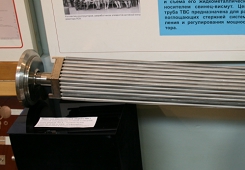
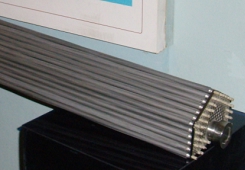
This part of the exposition is devoted to the submarine reactors. You can see the gift from the OKB (development bureau) "Gidropress" to the museum - model of the fuel assembly of the submarine reactor 705K in natural size. Number of fuel assemblies in a cassette depends on its place in the core of the reactor. In central pipes control rods are placed. Coolant in the projects 705 and 705K is a liquid-metal lead-bismuth composition.
Group of participants in nuclear energy facility "TOPAZ" testing.
(from the left to the right) A.I.Eltzov, V.A.Kuznetzov, P.M.Bogomolov, I.N. Polezhaeva, F.P.Raskach.
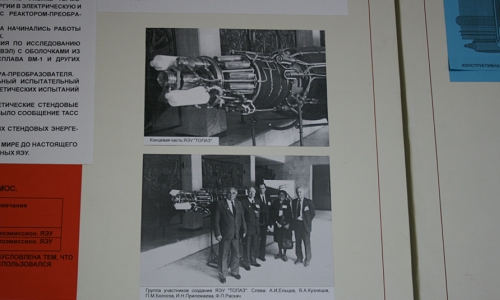
Technological channel of the device "TOPOL".
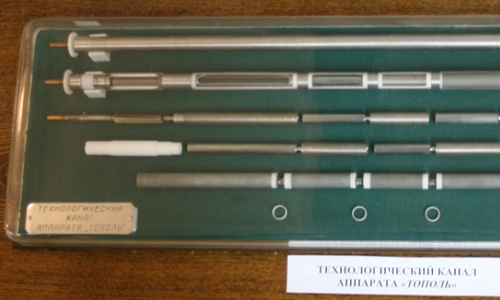
The most famous small reactor project where IPPE participated is a space nuclear energy facility "TOPAZ". Here is the photo of the group of participants in testing of this vehicle, and here is the technological channel of "TOPOL". You can see 5 concatenated electrogenerating elements of electron tube type (diode with cesium plasma). Electricity is taken from the output of such a channel.
Bright future of fast neutron reactors
And certainly our museum tour will be partial if we pass through our glorious past and bright future - fast sodium reactors BN.
Top of the BN-350 fuel assembly (left).
Beryllium-antimony neutron source for the fast reactors (right).
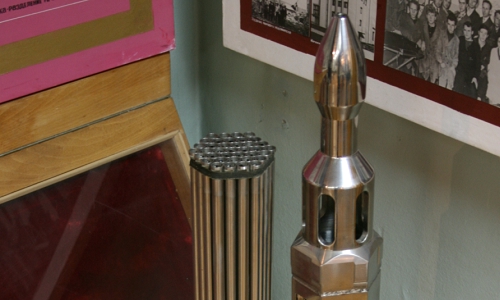
On the left side you can see the top of BN-350 fuel assembly. Right from it antimonous-beryllium neutron source for the fast reactors is situated. In the town Shevchenko it was used to maintain minimum level of the neutron flux in the stopped reactor. Construction of the source is rather complex, it consists of 7 antimonous and 30 beryllium elements. But on the other hand it helped to increase reliability and get rid of the danger of water leak to the coolant circuit.
Laureates of the Lenin prize
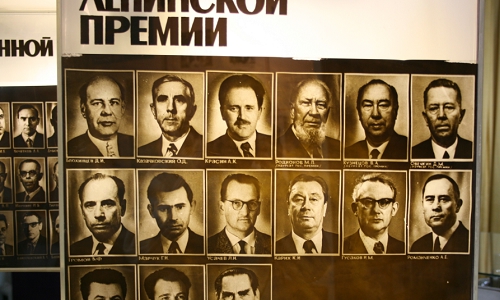
Laureates of the State prize
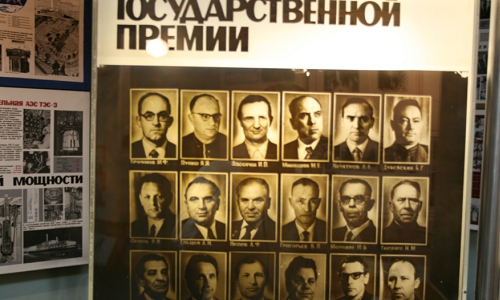
Work of IPPE scientists and engineers for the benefit of the nuclear industry was repeatedly rewarded with the high awards of Motherland. On these stands our Laureates of Lenin and State Prizes are presented. And we can make a separate excursion devoted to the life and work of each of them.
Time of our IPPE museum tour is going to the end. Unfortunately we are leaving this place. But the conversation with our delicious guides is not over. What are the interests of the nuclear museum? How can history help our contemporaries and contribute to the renaissance of the nuclear energy? Record of the conversation with the enthusiasts of the museum group will be published in the closest issues of AtomInfo.Ru.

SOURCE: AtomInfo.Ru
DATE: March 17, 2008